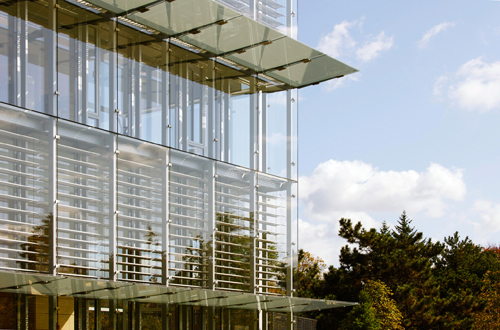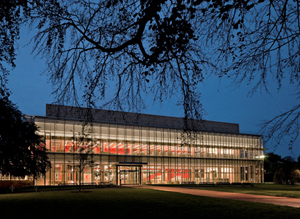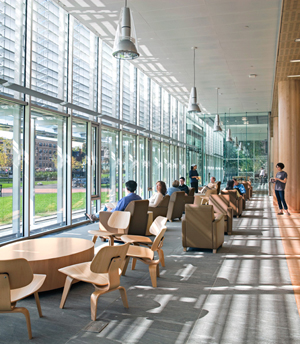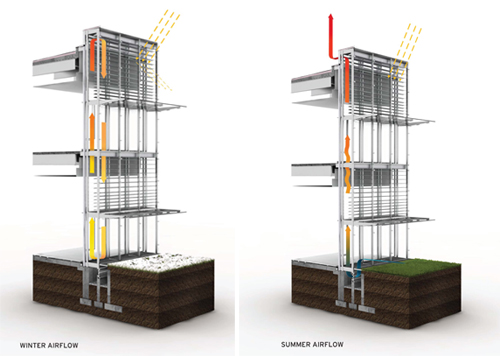More Than Skin Deep
Luminous library
Given all the variables and components, optimizing the performance of a double-skin facade is not as straightforward as that for a standard curtain-wall assembly. Energy modeling of a double-skin curtain wall involves not only thermal analysis of the complete assembly, but also analysis of the contribution of dynamic components, such as blinds and vents, explains Andrew Hall, a director in the London office of Arup. A double-skin facade "is not a static system," he says. Hall's firm served as facade consultant for the new central branch of the Cambridge Public Library, in Cambridge, Massachusetts.
 |
The Cambridge Public Library's double-skin facade has horizontal louvers and laminated-glass visors to mitigate direct solar penetration. Photo: © Chuck Choi |
Â
 |
The architects opted for an all-glass facade to make the building inviting at all times of day. Photo: Robert Benson |
 |
A 15-foot-wide strip of the interior immediately next to the curtain wall is column-free to enhance the connection with the surrounding park. Photo: Robert Benson |
Despite the inherent complexities, the library's designers saw a double-skin as the perfect solution for the building's main facade. They desired a transparent expression, but a typical single-wall curtain wall was impractical because of the southwest exposure and the associated heat gain and potential for glare. "We wanted the building to be welcoming from the outside, luminous at night, and not intimidating," says Clifford Gayley, a principal at Boston-based William Rawn Associates, the project's lead architect. In addition, the architects sought to establish a relationship between the library's interior and the 4-acre city park that surrounds it. And they hoped to avoid dwarfing the much smaller original library - a late-19th-century masonry building by Van Brunt & Howe restored as part of the $70 million project. The new, 76,700-square-foot structure is connected to the 27,200-square-foot historic building, quadrupling the size of the library.
The team developed a double-wall assembly, 180 feet long and 42 feet tall, with an outer skin of 1â„2-inch tempered low-iron glass and an inner, thermally broken skin of 1-inch IGUs. The two layers define a 3-foot-wide, two-story cavity that serves as a thermal flue: Depending on the season, louvers at the top and bottom of the wall can be opened or closed, to vent or to warm the air within.
Because the connection between indoors and out was such an important part of the concept, the project team worked hard to limit the visual obstructions between the library interior and the park. Their first move was to cantilever the strip of floor slab immediately behind the double skin from a row of columns 15 feet away, creating a zone free of large vertical elements at the building's edge.
To support the curtain wall, the team devised a framing system that was as minimal as possible but still able to withstand the necessary loads. The structure includes 33 vertically oriented Vierendeel trusses spaced 5 feet 6 inches apart and connected by catwalk grilles and steel angles. Because the vertical trusses contain no diagonals and because the horizontal members are placed above or below occupants' sight lines, views through the facade, even at oblique angles, are relatively unimpeded, explains Hall.
Sunshades within the cavity for controlling direct sunlight penetration are always extended and are set to one of two possible angles, depending on the season or time of day. But in keeping with the design mandate for unobstructed views, the shades shield only the upper portion of the two floors behind the curtain wall. The first 8 feet of these floors are instead protected by laminated-glass visors that project from the building face and have a slight gray tint. "It was important that they cut the transmission of light but still be read as glass," explains Gayley.
The product of all of these carefully considered design decisions is a crisply detailed crystalline facade optimized for its orientation. "A double skin is not the only way of achieving a green facade," says Arup's Hall. But, he adds, it makes sense where daylighting, protected shading, and transparency are desired.
 |
During the winter, closed vents at the top and bottom of the cavity allow the air within to heat up, creating a thermal barrier between exterior and interior. During the summer, the vents are opened to allow cool air to enter at the base and exit at the top as it warms, via the stack effect. |








